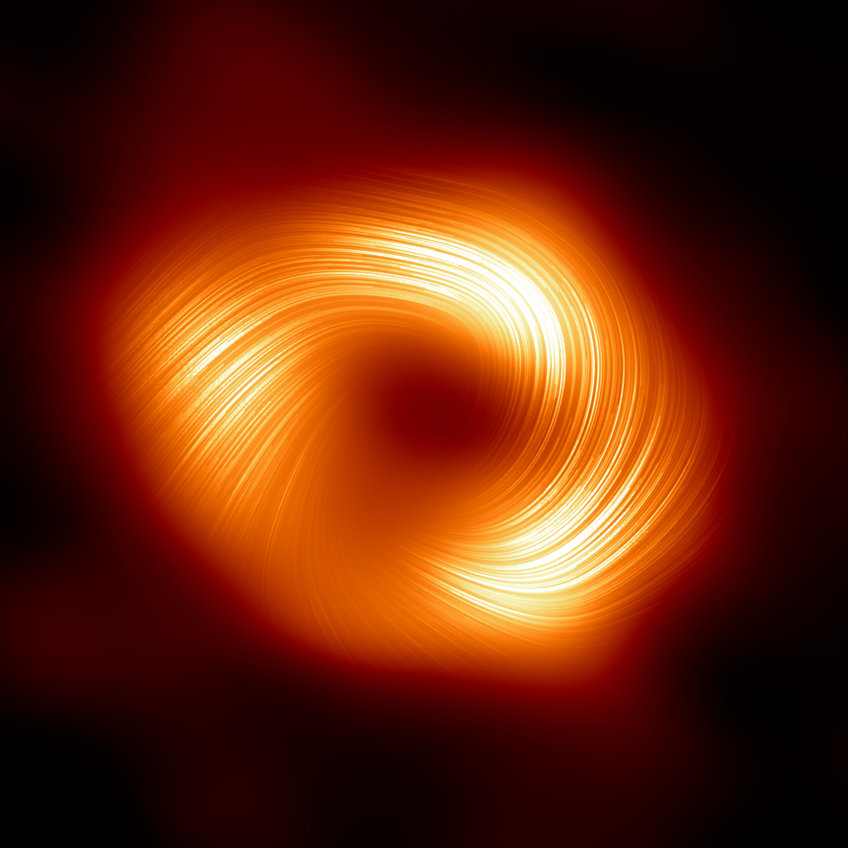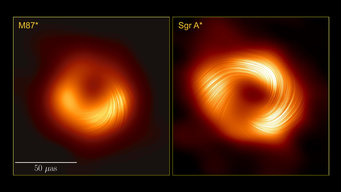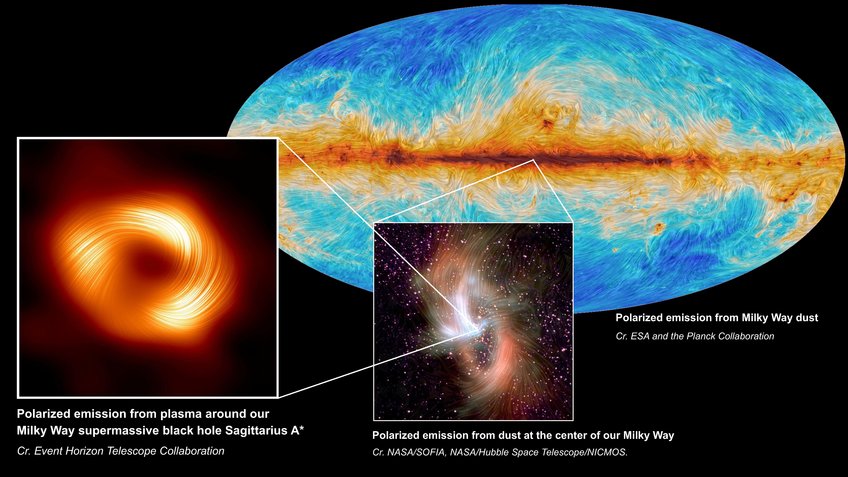Magnetic fields spiral around the mass monster Sagittarius A* and form up for a restart
The Event Horizon Telescope, a network of individual radio telescopes located all over the world, has once again observed the centre of our galaxy, the Milky Way. Using the polarised part of the radio light, the researchers discovered strong magnetic fields that spiral out from the edge of the supermassive black hole Sagittarius A*. The results indicate that a jet could be dormant in the centre of our galaxy, which - as models suggest - probably ejected large amounts of matter into space only a few million years ago.

The first image of the black hole Sagittarius A* in the center of the Milky Way, taken with the Event Horizon Telescope at a wavelength of 1.3 millimetres (colored image in the background). The lines correspond to the direction of polarization of the radio light, which indicates a magnetic field that is spiraling out of the image plane and that is perpendicular to the direction of polarization.
© The EHT Collaboration
The first image of the black hole Sagittarius A* in the core of the Milky Way, which is around 27,000 light years away from Earth, was published in 2022. It showed that although the supermassive black hole in the Milky Way is more than a thousand times smaller and less massive than that of M87, it still looks remarkably similar. This made scientists wonder whether the two shared common traits that are independent of their mass. New data show such a feature - with far-reaching consequences.

To telescopes, the supermassive black holes M87* (left) and Sagittarius A* (right) appear to be confusingly similar and almost the same size. This is despite the fact that the luminous ring around SgrA* would just fit into the orbit of Mercury, while the ring around M87* is slightly larger than our entire solar system. The explanation: With 55 million light years, M87* is thousands of times further away from us than SgrA* with only 27.000 light years.
© The EHT Collaboration
The spiral magnetic fields anchored in the vicinity of the mass monster in M87, which have already been mapped in polarised light, bundle together to form a jet. The magnetic forces inherent in the jet accelerate inflowing matter from the accretion disk at almost the speed of light into space. New observations of polarised light from the immediate vicinity of Sagittarius A*, which were carried out with significant participation of the Max Planck Institute for Radio Astronomy in Bonn, show a very similar stream of magnetic fields, which could also indicate a jet. However, despite the strong and ordered magnetic fields detected in the centre of the Milky Way, the jet is very weak at best. The data now collected should answer why this is the case.
Polarised light reveals magnetic fields
Light is an oscillating, or moving, electromagnetic wave that allows us to see objects. Sometimes, light oscillates in a preferred orientation, and we call it "polarized." The polarised part of the light contains a lot of additional information about the astrophysics of the mass monster and the mechanisms involved in the feeding of a black hole and the ejection of matter by the magnetic fields forming a jet. However, this light component is usually weaker and therefore more difficult to measure. Polarised radio light is produced when plasma, that is charged particles such as those found in the vicinity of black holes, whirl around ordered magnetic fields. The plane of oscillation of the polarised light is then perpendicular to the magnetic field, making it possible to map the magnetic field around the black hole.

Image of the central black hole Sagittarius A* in polarized radio light (left), which is located in the center of the Milky Way, which is also shown in polarized radio light in the image of the Planck satellite at the top right. The polarized infrared emission of the extended central region of the Milky Way is shown in the middle. The latter image was taken with the Sofia Observatory.
© Left: EHT Collaboration, Center: NASA/SOFIA, NASA/HST/NICMOS, Back right: ESA/Planck Collaboration
Although polarized light surrounds us, to human eyes it is indistinguishable from "normal" light. In the radio range, the telescopes' special detectors help to measure how strongly the wave crests and troughs are tilted to the side. "However, visualising black holes in polarised light isn't as easy as putting on a pair of polarised sunglasses," emphasises Maciek Wielgus, astronomer at the Max Planck Institute for Radio Astronomy. This is especially true for Sagittarius A*, because its radio-bright environment changes rapidly as the plasma orbits the black hole. However, in order for the polarised part of the light to be detectable at all, the telescopes have to look at it for a comparatively long time, which blurs the image, similar to a long-term image of a waterfall. "It was a considerable challenge when analysing the data to navigate through these fluctuations," adds Wielgus.
Relics of a jet in the Galactic Centre
"The revelation of these magnetic fields opens a window into the innermost regions of Sagittarius A*, where the interplay of gravity, magnetism and spacetime curvature reaches its zenith", says Anton Zensus is Director at the Max Planck Institute for Radio Astronomy and Founding Chair of the Event Horizon Telescope Collaboration. The magnetic fields in the centre of the Milky Way indicate a jet, which, in contrast to M87, is not collimated enough to blast a significant amount of matter into space. Due to the lower mass and thus gravitational pull of Sagittarius A*, less matter flows towards the centre and the jet base as opposed to the case of M87. This also leaves less matter that could be transported outwards via the jet. However, this was not necessarily always the case. Large X-ray bright bubbles above and below the plane of the Milky Way, which have been observerd by the eROSITA telescope and others, indicate that a jet was active in the core of our galaxy a few million years ago. It is not uncommon for such jets to lose power, shut down and relaunch.
But even if there was an active jet in the centre of the Milky Way, the Galactic centre is far enough away from Earth for the ejections of matter and radiation from the jet to be fatal for us. On the other hand, Sagittarius A* is the supermassive black hole located closest to us. This means that the magnetic field turbulence in the centre can be studied very well even if it only emits a weak polarisation signal and - at least at the moment - does not form a mature jet. With the additional data that the Event Horizon Telescope has obtained from the centres of the galaxy M87 and our Milky Way, the researchers see an opportunity to study jets in the greatest possible detail, from head to toe and potentially in all evolutionary stages.
The Event Horizon Telescope has carried out several observations since 2017, and is scheduled to observe Sgr A* again in April 2024. Each year the images improve as the Event Horizon Telescope adds new telescopes, wider bandwidths and new observation frequencies. Extending the telescope network into space will provide sharper images of black holes than ever before. In the next decade, the team around the world's largest radio telescope network will be able to present high-resolution films showing how the plasma flows around the black hole. These data may then also reveal the frustrated jet at the centre - this is what researchers call a jet that has strong magnetic fields, which, however, have not (yet) coiled up to form a tightly wound spring that accelerates matter from the inside outwards.
BEU
Additional Information
The EHT collaboration involves more than 300 researchers from Africa, Asia, Europe, and North and South America. The international collaboration is working to capture the most detailed black hole images ever obtained by creating a virtual Earth-sized telescope. Supported by considerable international investment, the EHT links existing telescopes using novel systems - creating a fundamentally new instrument with the highest angular resolving power that has yet been achieved.
The individual telescopes involved in the EHT in April 2017, when the observations were conducted, were: the Atacama Large Millimeter/submillimeter Array (ALMA), the Atacama Pathfinder EXperiment (APEX), the Institut de Radioastronomie Millimetrique (IRAM) 30-meter Telescope, the James Clerk Maxwell Telescope (JCMT), the Large Millimeter Telescope Alfonso Serrano (LMT), the Submillimeter Array (SMA), the UArizona Submillimeter Telescope (SMT), the South Pole Telescope (SPT). Since then, the EHT has added the Greenland Telescope (GLT), the IRAM NOrthern Extended Millimeter Array (NOEMA) and the UArizona 12-meter Telescope on Kitt Peak to its network. Data were processed at the correlator facilities at the MPI für Radioastronomie in Bonn, Germany, and MIT/Haystack Observatory in Massachusetts, USA.
The EHT consortium consists of 13 stakeholder institutes: the Academia Sinica Institute of Astronomy and Astrophysics, the University of Arizona, the University of Chicago, the East Asian Observatory, Goethe-Universitaet Frankfurt, Institut de Radioastronomie Millimétrique, Large Millimeter Telescope, Max Planck Institute for Radio Astronomy, MIT Haystack Observatory, National Astronomical Observatory of Japan, Perimeter Institute for Theoretical Physics, Radboud University and the Smithsonian Astrophysical Observatory.






